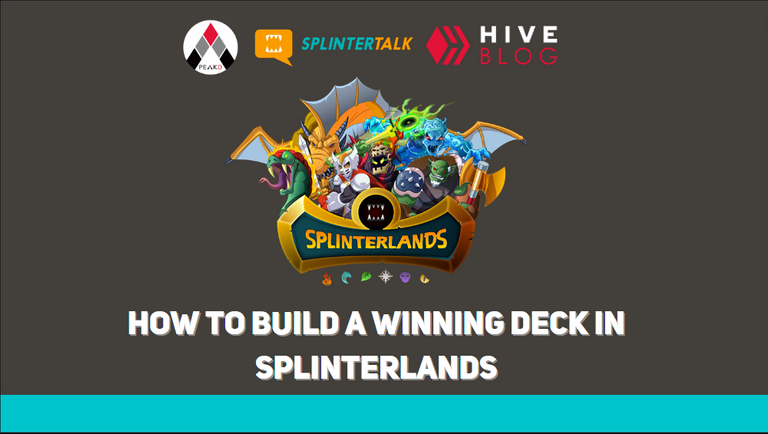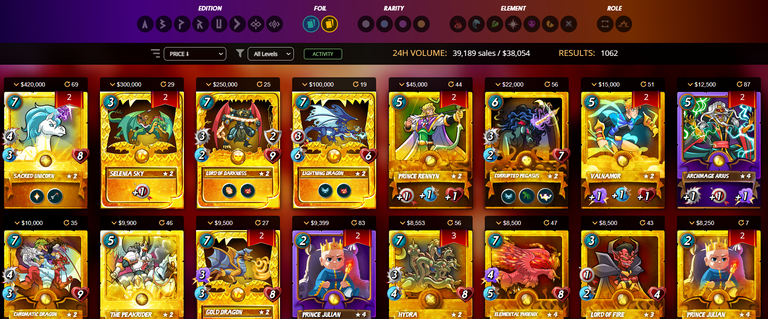How to Build a Winning Deck in Splinterlands
Splinterlands

Splinterlands is a popular online collectible card game that is built on blockchain technology. In Splinterlands, players build decks of monsters and battle against each other in turn-based combat, with the goal of defeating their opponent's monsters and reducing their life total to zero. The game features a variety of different Splinters (factions), each with their own unique monsters and play styles, as well as a range of game modes and tournaments for players to compete in.
Splinterlands also features a player marketplace where cards and other in-game items can be bought and sold using cryptocurrency. With its strategic depth, engaging gameplay, and unique blockchain-based economy, Splinterlands has become a favorite among both casual and competitive gamers alike.

To build a winning deck in Splinterlands, you should consider the following factors:
Understand the strengths and weaknesses of each Splinter (Faction) and their monsters
Each Splinter has its unique playstyle and monsters with different abilities and stats. By understanding each Splinter's strengths and weaknesses, you can select the most appropriate monsters to fit your playstyle and counter your opponents' strategies. You can also take advantage of synergies between monsters from the same Splinter.
Consider the ruleset and adjust your deck accordingly
In Splinterlands, there are different rulesets that apply to matches, such as mana caps, monster restrictions, and special abilities. You should adjust your deck to make the most of the ruleset and ensure that your team can perform well under the given constraints.
Choose monsters that complement each other and create a balanced team
A balanced team consists of monsters that cover each other's weaknesses and synergize well. For example, a tanky monster with high health can protect your more fragile monsters, while a fast monster with the "snipe" ability can take out high-priority targets.
Utilize a mix of melee, ranged, and magic attackers to cover different scenarios
Melee monsters deal high damage up close, ranged monsters can attack from a distance, and magic attackers can bypass armor and shields. By including a mix of these types of monsters, you can adapt to different situations and counter your opponent's strategies.
Add support cards that can buff your monsters or debuff your opponent's monsters
Support cards can have a significant impact on the outcome of a match. Buffs can increase your monsters' stats or give them special abilities, while debuffs can weaken your opponents' monsters or limit their actions.
Take advantage of the "Summoner" ability to enhance your team's abilities
The Summoner ability provides an extra layer of strategy by allowing you to enhance your team's abilities with various buffs and abilities. By choosing the right Summoner, you can increase your monsters' strength and resilience, giving you an edge in battle.
Keep your deck size small (usually around 30 cards) to increase consistency and reduce randomness
A smaller deck size means you're more likely to draw the monsters you need to execute your strategy. It also reduces the chance of drawing weaker cards that may not be useful in the current game.
Regularly test and tweak your deck to adapt to the changing meta and stay ahead of the competition
The Splinterlands meta is constantly evolving as new monsters and strategies emerge. To stay competitive, you should regularly test your deck against a variety of opponents and adjust it to remain effective. This can involve replacing weaker cards, modifying the Summoner, or even switching to a different Splinter altogether.
Do we have to spend money?
You do not have to spend money to build a winning deck in Splinterlands. While it is possible to buy cards, packs, and other items with real money, it's also possible to earn them through gameplay.
There are several ways to earn cards and other rewards in Splinterlands, such as completing daily quests, winning battles, and participating in tournaments. These rewards can provide you with a steady stream of new cards to add to your collection and improve your deck over time.
Additionally, there is a robust player marketplace where you can buy and sell cards with other players using a cryptocurrency called DEC (Dark Energy Crystals), which can be earned in-game or purchased on a cryptocurrency exchange.
While spending money can help you acquire new cards more quickly, it's not necessary to build a competitive deck. With careful strategy and smart deck-building, you can achieve success in Splinterlands without spending any money at all.
Does it take you a lot of time?
Building a winning deck in Splinterlands can take some time and effort, but the amount of time required can vary depending on several factors, such as your experience level, the strategies you use, and the resources available to you.
If you're new to the game and just starting out, it may take some time to learn the mechanics of the game and understand the different Splinters and their monsters. You'll also need to build up your card collection, which can take some time depending on how often you play and how many rewards you earn.
However, as you gain experience and become more familiar with the game, you'll likely start to develop your own strategies and play style, which can help you become more efficient and effective in building your deck.
It's also worth noting that the time required to build a winning deck in Splinterlands can vary depending on your goals. If you're simply looking to have fun and enjoy the game, you can take your time and experiment with different strategies at your own pace. On the other hand, if you're aiming to be a top player or compete in high-level tournaments, it may take more time and effort to achieve your goals.
Summary
Building a winning deck in Splinterlands does not necessarily require spending money, although doing so can help you acquire new cards more quickly. Players can earn cards and other rewards through gameplay, and there is also a player marketplace where cards can be bought and sold with the in-game currency DEC. The amount of time required to build a winning deck can vary depending on factors such as experience level, strategies used, and resources available. It may take some time to learn the mechanics of the game and build up a card collection, but as players become more familiar with the game and develop their own strategies, they can become more efficient and effective in building their deck. Ultimately, the time required to build a winning deck will depend on individual goals, such as whether players are looking to have fun or compete at a high level.
https://twitter.com/1101433434923184128/status/1625709866382917633
The rewards earned on this comment will go directly to the people( @farhunt ) sharing the post on Twitter as long as they are registered with @poshtoken. Sign up at https://hiveposh.com.
Thanks for sharing! - Underlock#8573
